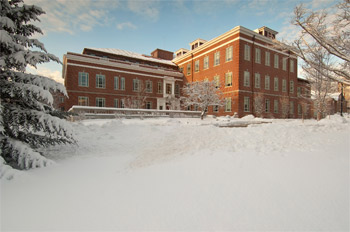UNH's James Hall Granted LEED Gold Certification
DURHAM, N.H. - The University of New Hampshire's James Hall has received LEED Gold certification from the U.S. Green Building Council for its $34.2 million renovation and expansion. James Hall, which houses the UNH departments of Earth sciences and natural resources and the environment, is the first UNH building project to seek LEED (Leadership in Energy and Environmental Design) certification.
The renovation and expansion, a collaboration with Shawmut Construction and Design and EYP Architecture and Design, was supported by the KEEP-NH (Knowledge Economy Education Plan) capital improvements initiative. It began in August 2008 and finished in January 2010.
"This gold certification exemplifies and advances UNH's long-standing commitment to sustainability, energy efficiency, resource conservation and enduring facility construction," says Douglas Bencks, university architect and director of campus planning. "We sought silver certification but achieved gold, thanks in part to the project team's attention to energy efficiency and several innovative components."

Sustainable innovations in James Hall include a gray water system that captures rainwater from the building's roof and gutters for use in toilets and urinals; daylight harvesting, which utilizes sensors to turn off electrical fixtures when natural daylight provides adequate light; and a heat wheel recovery system, which makes the air handling unit extremely efficient. In addition, 20 percent of the materials used in the renovation consist of recycled content, and 30 percent of the materials were extracted and manufactured within 500 miles of Durham. Visitors to James Hall can monitor energy use live via an interactive energy kiosk in the building.
Built in 1929 to house the chemistry department, James Hall - named for chemistry professor Charles James - had not undergone much renovation throughout its history, yet the "bones" of the building were intact. While the renovation increased the building's size by 14,000 square feet, it salvaged and restored many important architectural characteristics, including the central stairway and 75 percent of existing exterior walls, floors and roof, to maintain the character of the building.
Additional features of the renovation include a "green" roof that uses plantings to clean and conserve water; an outdoor "classroom" featuring a slate chalkboard from the original building; and an 1878 wooden New Hampshire geological relief map by Charles Hitchcock, restored by Professor Emeritus of geology Wally Bothner.
The University of New Hampshire, founded in 1866, is a world-class public research university with the feel of a New England liberal arts college. A land, sea, and space-grant university, UNH is the state's flagship public institution, enrolling 12,200 undergraduate and 2,200 graduate students.
-30-
Multimedia:
Watch a video of the James Hall renovation: http://vimeo.com/8995719
Watch a video of the Hitchcock Map renovation: http://vimeo.com/8972779
Photographs available to download:
/unhtoday/news/cj_nr/2010/apr/bp22james_02.jpg
Caption: James Hall, built in 1929, has received LEED Gold certification.
Credit: Perry Smith, UNH Photographic Services
/unhtoday/news/cj_nr/2010/apr/bp22james_01.jpg
Caption: The renovation of James Hall restored many important architectural characteristics, including the central stairway.
Credit: Lisa Nugent, UNH Photographic Services
/unhtoday/news/cj_nr/2010/apr/bp22james_03.jpg
Caption: As part of the James Hall renovation, Professor Emeritus of geology Wally Bothner restored a unique 1878 wooden New Hampshire geological relief map by Charles Hitchcock.
Credit: Perry Smith, UNH Photographic Services
/unhtoday/news/cj_nr/2010/apr/bp22james_04.jpg
Caption: The renovation of James Hall, the first building project at UNH to seek LEED certification, retained the signature yellow brick interior walls.
Credit: Perry Smith, UNH Photographic Services
Latest News
-
November 5, 2025
-
October 24, 2025
-
October 8, 2025
-
October 2, 2025
-
September 24, 2025















































